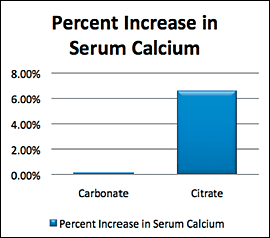New York's highest court of appeals has held that no-fault insurers cannot deny no-fault benefits where they unilaterally determine that a provider has committed misconduct based upon alleged fraudulent conduct. The Court held that this authority belongs solely to state regulators, specifically New York's Board of Regents, which oversees professional licensing and discipline. This follows a similar recent ruling in Florida reported in this publication.
Top 5 Myths and Realities of Dietary Supplements
In my years as a clinician, I have heard many "myths" that are spoken as fact in regards to what supplements can be used for, when they should be used and if they are needed at all. I hope to shed some light on several of the more common myths so you are equipped to make the best decision for you and the overall health of your patients.
Myth #1
"If I take supplements I don't have to worry about diet and exercise." This is a statement that I have seen practiced by many people and it could not be further from the truth. Supplements are just that, a supplement to a healthy diet and lifestyle. Eating well everyday and getting daily activity or exercise are the foundation of health. If your patients are not practicing a healthy lifestyle, they will likely never reap the tremendous benefits of the potent combination of healthy lifestyle and appropriate dietary supplement use.
Myth #2
"I can get all the nutrients I need from my diet." This myth is at the opposite end of the spectrum from myth #1. Many people still feel that a healthy, well balanced diet will provide enough of the correct nutrients to allow the body to work at its full potential. As much as it pains me to say, this is no longer possible, as our food is too weak to build up nutrient stores in a nutrient depleted body. The data gathered over the last 50-70 years on the nutrient content of fruits as vegetables show a "median decline of 5% to 40% or more in minerals, vitamins and protein in groups of foods, especially in vegetables."
When looking at this data, you would have to eat almost two times the quantity of food that you currently eat to get the same nutrient intake as during the early 1900's. This would be very difficult, if not impossible, to do and still take in an appropriate quantity of calories. If that is not convincing enough, just take a look at the dietary reference intakes (DRI) values set by the U.S. Department of Agriculture and compare them to the level of nutrients (vitamins, minerals, etc.) ingested per capita per day reported by the USDA.
You would see that on average, the general population is not meeting all of their nutrient needs with diet alone. This should be rather alarming, as the DRI is the minimum level set to prevent the occurrence of the diseases associated with a gross deficiency of each of the nutrients, not the level to promote optimum function.
Myth #3
"All multivitamins are the same thing, so I should just buy the least expensive option." The body's biochemistry is complex, including how it absorbs and utilizes vitamins, minerals and other nutrients regularly found in a multivitamin formulation. The differences in the ability to absorb different forms of nutrients found in a multivitamin are quite staggering. For example, let's consider calcium. When looking at calcium within a multivitamin, you may see calcium carbonate, calcium citrate or many other forms.

There is a difference is the amount of actual calcium (called elemental calcium) in different forms, so 500 mg of calcium carbonate and 500 mg of calcium citrate are not really the same amount of calcium. Add to that the different absorption and utilization rates (referred to as "bioavailability") of these different forms, and the equation gets even more complex. While calcium carbonate has the highest percentage of elemental calcium, it is not very bio-available. When comparing the amount of elemental calcium that is absorbed, it is much better to use a supplement with calcium citrate in it because the much higher bioavailability more than makes up for the lower amount of elemental calcium (See Table 1). The use of the citrate form will result in an overall higher level of calcium being absorbed by the body.
[pb]Another very important aspect of choosing the right multivitamin is quality. It is of the utmost importance for you to choose a product that you trust and one that has been tested by independent labs to ensure potency and purity, allowing you to recommend the best product possible to your patients.Myth #4
"My urine is fluorescent yellow; all of the vitamins I take are just creating expensive urine!" This is a comment that I have heard from patients many times. This color change is associated with the B vitamin riboflavin. Its structure causes the "glowing" yellow urine that your patients may have seen. Don't worry; this isn't causing your patients harm. B vitamins are water soluble, so your body doesn't store them long term. The color change is just extra riboflavin being excreted. (In fact, if it's in the urine, it means it got into the bloodstream first!) When a B vitamin supplement is taken and this change occurs, this result is not bad, because the body is getting enough to run the proper functions and excreting the rest as waste. If patients are taking a B vitamin complex and this isn't happening, they might actually need to take more, because the body is using everything that was provided in the supplement and they may benefit from a bit of a higher dose.
Myth #5
"Taking all of my supplements at once has the same effect as splitting up the dosing throughout the day." In our time crunched lives, we are always looking for something to make our day easier. When it comes to the vitamins and supplements that patients are taking, most people just want to get it over with and not have to think about it again that day. For some supplements, such as the fat soluble vitamins A, D, E and K, it is okay to take one dose daily as your body will build up its storage of these nutrients to use when extra is needed. With most other supplements, the body is unable to build up longer-term storage, so it is most appropriate to split the daily dose into 2 or 3 administrations.
I have told my patients many times that if they would be able to take a small dose each hour throughout the day, this would be the best case scenario, as your body will have a constant "drip" of nutrients at hand to support daily function. While I know this is not likely to happen, I make the statement to highlight the importance of dividing the dose up throughout the day. Another consideration is the timing of the dose. Certain dietary supplements are designed to be taken right before going to sleep, upon rising, or at a specific time in the afternoon. If this timing was not followed, the intended benefit of the supplement may not be realized.
Bonus Myth
"It is unsafe to take medications and supplements at the same time." This is a myth due to its broad blanket-statement nature. While many interactions exist between pharmaceutical medications and dietary supplements, (and make it unsafe to use the products in combination), most medications can be safely combined with supplements. Additionally, substitutes for interacting substances often exist. It's vital to refer to a trusted source that will provide you with the most up-to-date and relevant interactions and contraindications.
A great resource is provided by the National Institutes of Health on herbs and supplements. This resource also provides detailed information on the potential interactions with not only medications, but also other supplements, herbs and foods. You can find it at www.nlm.nih.gov/medlineplus/druginfo/herb_All.html.
Now that we've busted some of the most common myths about dietary supplements, you should be better prepared to use them personally or in your practice. As a rule of thumb, be sure to do your own research so you don't fall victim to believing in one of the many myths that surround the use of dietary supplements.
References
- Davis, Donald R. "Declining Fruit and Vegetable Nutrient Composition: What Is the Evidence." HortScience 44.1 (2009): 15-19. Print.
- "DRI Tables." USDA National Agricultural Library. USDA, n.d. Web. 28 Jan. 2013.
- Nutrient Content of the U.S. Food Supply, 1909-2000. Rep. no. 56. USDA Center for Nutrition Policy and Promotion, Nov. 2004. Web. 29 Jan. 2013.
- Hanzlik, R. P. "Relative Bioavailability of Calcium from Calcium Formate, Calcium Citrate, and Calcium Carbonate." Journal of Pharmacology and Experimental Therapeutics 313.3 (2005): 1217-222. Print.



